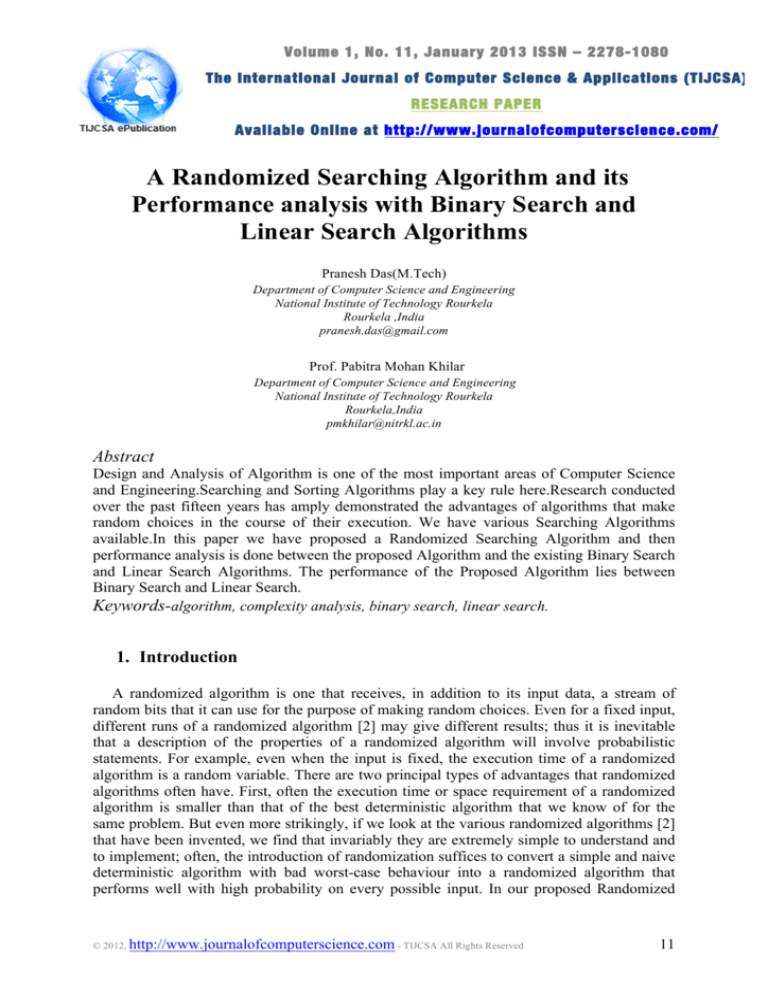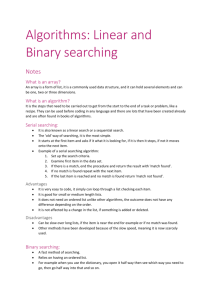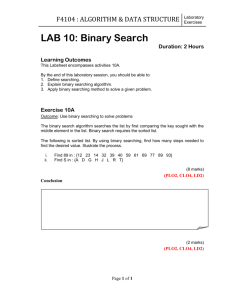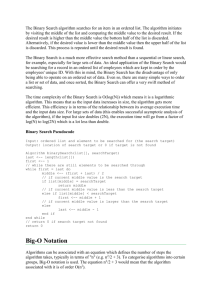
Volume 1, No. 11, January 2013 ISSN – 2278-1080
The International Journal of Computer Science & Applications (TIJCSA)
RESEARCH PAPER
Available Online at http://www.journalofcomputerscience.com/
A Randomized Searching Algorithm and its
Performance analysis with Binary Search and
Linear Search Algorithms
Pranesh Das(M.Tech)
Department of Computer Science and Engineering
National Institute of Technology Rourkela
Rourkela ,India
pranesh.das@gmail.com
Prof. Pabitra Mohan Khilar
Department of Computer Science and Engineering
National Institute of Technology Rourkela
Rourkela,India
pmkhilar@nitrkl.ac.in
Abstract
Design and Analysis of Algorithm is one of the most important areas of Computer Science
and Engineering.Searching and Sorting Algorithms play a key rule here.Research conducted
over the past fifteen years has amply demonstrated the advantages of algorithms that make
random choices in the course of their execution. We have various Searching Algorithms
available.In this paper we have proposed a Randomized Searching Algorithm and then
performance analysis is done between the proposed Algorithm and the existing Binary Search
and Linear Search Algorithms. The performance of the Proposed Algorithm lies between
Binary Search and Linear Search.
Keywords-algorithm, complexity analysis, binary search, linear search.
1. Introduction
A randomized algorithm is one that receives, in addition to its input data, a stream of
random bits that it can use for the purpose of making random choices. Even for a fixed input,
different runs of a randomized algorithm [2] may give different results; thus it is inevitable
that a description of the properties of a randomized algorithm will involve probabilistic
statements. For example, even when the input is fixed, the execution time of a randomized
algorithm is a random variable. There are two principal types of advantages that randomized
algorithms often have. First, often the execution time or space requirement of a randomized
algorithm is smaller than that of the best deterministic algorithm that we know of for the
same problem. But even more strikingly, if we look at the various randomized algorithms [2]
that have been invented, we find that invariably they are extremely simple to understand and
to implement; often, the introduction of randomization suffices to convert a simple and naive
deterministic algorithm with bad worst-case behaviour into a randomized algorithm that
performs well with high probability on every possible input. In our proposed Randomized
© 2012, http://www.journalofcomputerscience.com - TIJCSA All Rights Reserved
11
Pranesh Das, Prof. Pabitra Mohan Khilar, The International Journal of Computer Science
& Applications (TIJCSA) ISSN – 2278-1080, Vol. 1 No. 11 January 2013
Searching Algorithm we choose a position randomly in each iteration and then the element of
that position is compared with the key item. The organization of the paper is as follows:
section 2 presents the related work, section 3 presents the proposed RSA algorithm and
section 4 presents about performance analysis of the proposed RSA algorithm with the
existing Binary Search and Linear Search Algorithms.
2. Related Work
Searching an item or data from a large data set efficiently gives a challenging task.There
are number of searching algorithms available like Binary Search, Linear Search,
DFS,BFS,BST etc. The studies on searching have been carried out by Francesc [1], Robert
[3] , Bharat [4], Ziqiang[5] and so on. Binary Search provides a very good performance
with respect to other algorithms but in this case every time we need to calculate the mid
position .Instead of this in our proposed RSA we choose a position randomly and compare
it with the key item because randomization improves the performance of an algorithm [2].
3. Proposed Randomized Searching Algorithm
3.1.
3.2.
Description
In our proposed Randomized Searching Algorithm the main idea
is to select positions randomly from the sorted input array and compare elements
of those positions with the search key until the match is found or the array is
finished. If the key element is found in the randomly selected position p then we
stop. If the search key is less than or greater than the element of the chosen
position then the searching is continued in the left side or in the right sight of the
position respectively. We have done the simulation in MATLAB
7.12.0(R2011a).We have generated the elements of the input array A randomly.
We also have generated the search key element K randomly and done the
simulation for a large no of times with arrays of different sizes.
Working of the proposed RSA
4. Results
4.1.
Performance Analysis of the Proposed RSA Algorithm
© 2012, http://www.journalofcomputerscience.com - TIJCSA All Rights Reserved
12
Pranesh Das, Prof. Pabitra Mohan Khilar, The International Journal of Computer Science
& Applications (TIJCSA) ISSN – 2278-1080, Vol. 1 No. 11 January 2013
4.1.1. Complexity Analysis We see that in the first two lines of the working of the
proposed RSA before the while loop, 2 primitive operations always get executed (two
assignments). However, since these operations happen no matter what the input is, we will
ignore them for now. Focusing our attention on the while loop, we see that each time the
program enters the while loop, we execute 3+k primitive operations (a <=comparison, k
number of operations to choose a random number between lb and ub, an array index, and a <
comparison), before the program might branch depending on the result of the first if
statement.
Depending on the result of the conditional, the program will execute different numbers of
primitive operations. If key > A[p] (A is the sorted input array) , then the program executes 2
more primitive operations. If key <A[p], then the program executes 4 more primitive
operations (an array index and a <comparison in the next if, and then a subtraction and
assignment). If A[p] = = key, then we execute 3 more primitive operations (2 operations for
the if and then 1 operation to return position p). As k is fix for each iteration so we neglect k
now. In other words, the number of primitive operations executed in an iteration of the loop is
5, if key < A[p] 6 , if A[p] = = key, and 7 , if key > A[P].
We can now construct a tree that summarizes how many operations are executed in the while
loop, depending on the number of times the while loop is executed and the result of the
comparisons between A[p] and key in each iteration. Each node in the tree represents the exit
from the algorithm because A[p] = = key. A node is a left child of its parent if in the previous
iteration of the while loop, the search was restricted to the left part of the sub array (that is,
when A[P] > key). A node is a right child of its parent if in the previous iteration of the while
loop, the search was restricted to the right part of the sub array (that is, when A[p] <key).
Here are the first three levels of the tree:
Figure 1: No. of operations as a tree structure
In case of Binary Search algorithm height of the left sub tree and the height of the right sub
tree are equal and we can easily proof that the average case time complexity [1] for binary
search is log n. Because the number of nodes are equal in both the left and right sub trees and
total number of nodes on each level can be easily computed. But in our proposed algorithm as
the position is randomly chosen so the height of left sub tree and the height of right sub tree
may not be equal.
Hence to analyse the average case behaviour we have done a simulation on our proposed
algorithm. We have done the simulation on the basis of number of elements versus number of
comparisons instead of number operations. In our described algorithm on section 3.2 the
© 2012, http://www.journalofcomputerscience.com - TIJCSA All Rights Reserved
13
Pranesh Das, Prof. Pabitra Mohan Khilar, The International Journal of Computer Science
& Applications (TIJCSA) ISSN – 2278-1080, Vol. 1 No. 11 January 2013
relevant number of comparisons (one <= comparison, one < and one >) executed in an
iteration of the loop is:
2, if key < A[p] 3, if A[p] = = key, and 3, if key > A[P].
We have simulated the proposed algorithm in MATLAB 7.12.0(R2011a).In the simulation
we have generated the elements of the arrays randomly and also the key. The simulation is
done for 50 times with different number of elements ranges from 10 to 500.The simulated
result for average case is shown below:
Table 1: Simulated Result for Average Case (no.of elements and no.of comparisons)
No.of eleme
nts No.of compa
risons No.of eleme
nts No.of compa
risons No.o
f elem
ents No.of compa
risons No.of No.of elem compar
ents isons No.of element
s No.of comp
ariso
ns 10 7 110 14 210 24 310 22 410 19 20 14 120 18 220 17 320 29 420 22 30 20 130 18 230 30 330 22 430 19 40 12 140 24 240 41 340 25 440 16 50 24 150 25 250 18 350 28 450 24 60 8 160 32 260 21 360 19 460 32 70 12 170 20 270 22 370 33 470 23 80 33 180 23 280 15 380 30 480 29 90 26 190 23 290 18 390 30 490 39 100 25 200 28 300 19 400 15 500 25 From the above table Table1 we see that in average approximately 3log n (base 2)
comparisons are required to find the key item for the different set of elements. Hence we can
say that approximately the time complexity of our proposed Randomized Searching
Algorithm is O(3log n) in Average Case.
For Best Case every time we find the key in the first attempt i.e. in the first loop and only 3
comparisons are performed for every set of elements.
In Worst Case key item is not in the input array i.e. in every iteration maximum number of
comparisons are performed. The simulation is done in MATLAB 7.12.0(R2011a) for the
worst case analysis. Here also we have generated the keys and the elements randomly and
done the simulation for 50 times with different number of elements ranges from 10 to
500.The simulated result for Worst Case is shown below:
Table 2: Simulated Result for Worst Case (number of elements and number of comparisons)
© 2012, http://www.journalofcomputerscience.com - TIJCSA All Rights Reserved
14
Pranesh Das, Prof. Pabitra Mohan Khilar, The International Journal of Computer Science
& Applications (TIJCSA) ISSN – 2278-1080, Vol. 1 No. 11 January 2013
No.o
f elem
ents No.o
f com
paris
ons No.of eleme
nts No.of compa
risons No.of eleme
nts No.of compa
risons No.of eleme
nts No.of compa
risons No.of eleme
nts No.of compa
risons 10 20 9 18 110 120 27 20 210 220 31 23 310 320 21 24 410 420 45 21 30 40 10 18 130 140 14 20 230 240 14 20 330 340 26 21 430 440 26 24 50 16 150 10 250 25 350 20 450 31 60 70 27 16 160 170 22 19 260 270 26 26 360 370 38 28 460 470 21 27 80 90 18 20 180 190 32 13 280 290 22 29 380 390 23 15 480 490 12 18 100 15 200 14 300 25 400 15 500 28 From the above table Table2 we observe that approximately in average the same
numbers of comparisons are required to find the key items for the different set of
elements as like as the average case. Hence we can say that in Worst Case also
approximately the time complexity is O(3 log n) .
4.1.2 Efficiency Graphs Compared to Binary Search and Linear Search Algorithms
Here we have shown the performance analysis of our proposed algorithm graphically.
In figure 2 we see that our Proposed Algorithm is performing approximately same as Binary
Search in average case. During simulation it is seen that some times our proposed algorithm
gives better result then the Binary Search. Here we did not get smooth graph because of
randomization. From figure 3 we see that our proposed algorithm is giving better result then
the existing linear Search Algorithm (although linear search is applied on unsorted array).
In figure 4 average case behaviour of Linear Search, Binary Search and RSA is shown. In
figure 5 worst case analysis is done. It is seen that average case and worst behaviour are
nearly same for our Proposed RSA Algorithm.
© 2012, http://www.journalofcomputerscience.com - TIJCSA All Rights Reserved
15
Pranesh Das, Prof. Pabitra Mohan Khilar, The International Journal of Computer Science
& Applications (TIJCSA) ISSN – 2278-1080, Vol. 1 No. 11 January 2013
Figure 2: Average Case behaviour of the proposed RSA and the existing Binary Search Algorithm
Figure 3: Average Case Behaviour of the Proposed RSA and the existing Linear Search Algorithm
© 2012, http://www.journalofcomputerscience.com - TIJCSA All Rights Reserved
16
Pranesh Das, Prof. Pabitra Mohan Khilar, The International Journal of Computer Science
& Applications (TIJCSA) ISSN – 2278-1080, Vol. 1 No. 11 January 2013
Figure 4: Average Case Performance Analysis of the Proposed RSA, Binary Search and Linear Search
Algorithms.
Figure 5: Worst Case Behaviour of the Proposed Randomized Search Algorithm (RSA) and the
existing Binary Search Algorithm.
© 2012, http://www.journalofcomputerscience.com - TIJCSA All Rights Reserved
17
Author ,The International Journal of Computer Science & Applications (TIJCSA), Vol.(XX) No.(XX), Month, 2011
5. Conclusion
Performance of the proposed RSA algorithm lies between Binary Search and Linear
Search Algorithms. With respect to Linear Search our algorithm gives better performance
although Linear Search is applied on unsorted data. Due to randomization we can get an
average result every time. We will improve the performance of the algorithm by designing
a proper algorithm to choose a number randomly.
References
[1] Francesc J. Ferri and Enrique Vidal, Case-Studies on Average-Case Analysis for an
Elementary Course on Algorithms, IEEE TRANSACTIONS ON EDUCATION,
VOL. 42, NO. 2, MAY 1999.
[2] Karp, R.M., An introduction to randomized algorithms, Discrete Applied Mathematics,
Computer Science Division, University of California Berkeley, International Computer
Science Institute, Berkeley, CA 94704, USA .
[3] Robert Nowak,Generalized Binary Search,Forty-Sixth Annual Allerton Conference
Allerton House, UIUC, Illinois, USA September 23-26, 2008.
[4] Bharat Singh, Ishadutta Yadav, Suneeta Agarwal, Rajesh Prasad, An Efficient Word
Searching Algorithm through Splitting and Hashing the Offline Text, 2009 International
Conference on Advances in Recent Technologies in Communication and Computing,
IEEE Explore.
[5] Ziqiang YU, Xianqiang Liu, Improvement of Dynamic Binary Search Algorithm
Used in RFID System, 2011 Cross Strait Quad-Regional Radio Science and Wireless
Technology Conference.
© 2012, http://www.journalofcomputerscience.com - TIJCSA All Rights Reserved
18






